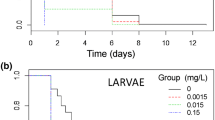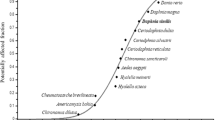Abstract
Systemic insecticides such as neonicotinoids and fipronil are widely applied in rice production. These insecticides have been suspected of reducing biodiversity in paddy ecosystems and reducing wild dragonfly populations in Japan. Conventional ecotoxicological risk assessment could not confirm this, as it has not considered interspecific variation in sensitivity to insecticides. We estimated the median effect concentration (EC50) of 15 systemic insecticides to first instar nymphs of a Japanese damselfly, Ischnura senegalensis (Rambur) (Odonata: Coenagrionidae), commonly found in rice paddy fields. Damselflies were found to be highly sensitive to pyrethroid pesticides, less so to phenylpyrazole, organophosphates, and carbamates, and least sensitive to neonicotinoids, nereistoxin, and diamide. Given the acute toxicity data, the sensitivity of the damselfly to neonicotinoids was considered to be lower than that of other aquatic insects, whereas the EC50 values of the damselfly were 2–3 orders lower than that of Daphnia magna Straus (Diplostraca: Daphniidae), which is a standard test species. These results indicate that the conventional ecological risk assessment based on acute toxicity data of D. magna would underestimate the impact of neonicotinoids on Odonata diversity in paddy ecosystems. We therefore recommend using the paddy-dwelling damselfly as a new test species for insecticide bioassay.


Similar content being viewed by others
References
Beketov M, Liess M (2008) Acute and delayed effects of the neonicotinoid insecticide thiacloprid on seven freshwater arthropods. Environ Toxicol Chem 27:461–470. https://doi.org/10.1897/07-322R.1
Chang X, Zhai B, Liu X, Wang M (2007) Effects of temperature stress and pesticide exposure on fluctuating asymmetry and mortality of Copera annulata (Selys) (Odonata: Zygoptera) larvae. Ecotoxicol Environ Saf 67:120–127. https://doi.org/10.1016/j.ecoenv.2006.04.004
Hainzl D, Casida JE (1996) Fipronil insecticide: novel photochemical desulfinylation with retention of neurotoxicity. Proc Natl Acad Sci USA 93:12764–12767. https://doi.org/10.1073/pnas.93.23.12764
Hayasaka D, Korenaga T, Suzuki K, Saito F, Sánchez-Bayo F, Goka K (2012) Cumulative ecological impacts of two successive annual treatments of imidacloprid and fipronil on aquatic communities of paddy mesocosms. Ecotoxicol Environ Saf 80:355–362. https://doi.org/10.1016/j.ecoenv.2012.04.004
Hayasaka D, Suzuki K, Korenaga T, Saito-Morooka F, Nomura T, Fukasawa K, Sánchez-Bayo F, Goka K (2013a) Effects of two successive annual treatments of two systemic insecticides, imidacloprid and fipronil, on dragonfly nymph communities in experimental paddies. Jpn J Pestic Sci 38:101–107. https://doi.org/10.1584/jpestics.w13-05 (in Japanese with English summary)
Hayasaka D, Suzuki K, Nomura T, Nishiyama M, Nagai T, Sánchez-Bayo F, Goka K (2013b) Comparison of acute toxicity of two neonicotinoid insecticides, imidacloprid and clothianidin, to five cladoceran species. J Pestic Sci 38:44–47. https://doi.org/10.1584/jpestics.D12-061
IRAC (2017) The IRAC mode of action classification Scheme version 8.2., Brussels. http://www.irac-online.org/. Accessed 9 May 2017
Japan Plant Protection Association (2011) Noyaku handbook, 13th edn. Japan Plant Protection Association, Tokyo
Jinguji H, Ueda T, Goka K, Hidaka K, Matsura T (2009) Effects of imidacroprid and fipronil insecticide application on the larvae and adult of Sympetrum frequens (Libellulidae: Odonata). Trans Jpn Soc Irrigat Drain Reclamat Eng 259:35–41. https://doi.org/10.11408/jsidre.77.35 (in Japanese with English summary)
Jinguji H, Thuyet DQ, Uéda T, Watanabe H (2013) Effect of imidacloprid and fipronil pesticide application on Sympetrum infuscatum (Libellulidae: Odonata) larvae and adults. Paddy Water Environ 11:277–284. https://doi.org/10.1007/s10333-012-0317-3
Kadoya T, Akasaka M, Aoki T, Takamura N (2011) A proposal of framework to obtain an integrated biodiversity indicator for agricultural ponds incorporating the simultaneous effects of multiple pressures. Ecol Ind 11:1396–1402. https://doi.org/10.1016/j.ecolind.2011.03.001
Kasai A, Hayashi TI, Ohnishi H, Suzuki K, Hayasaka D, Goka K (2016) Fipronil application on rice paddy fields reduces densities of common skimmer and scarlet skimmer. Sci Rep 6:23055. https://doi.org/10.1038/srep23055
Katayama N, Baba YG, Kusumoto Y, Tanaka K (2015) A review of post-war changes in rice farming and biodiversity in Japan. Agric Syst 132:73–84. https://doi.org/10.1016/j.agsy.2014.09.001
Kobashi K, Harada T, Adachi Y, Mori M, Ihara M, Hayasaka D (2017) Comparative ecotoxicity of imidacloprid and dinotefuran to aquatic insects in rice mesocosms. Ecotoxicol Environ Saf 138:122–129. https://doi.org/10.1016/j.ecoenv.2016.12.025
Nagai T (2016) Ecological effect assessment by species sensitivity distribution for 68 pesticides used in Japanese paddy fields. J Pestic Sci 41:1–9. https://doi.org/10.1584/jpestics.D15-056
Organization for Economic Cooperation and Development (OECD) (2004) Daphnia sp., acute immobilization test, vol 202. OECD, Paris
Pisa LW, Amaral-Rogers V, Belzunces LP et al (2015) Effects of neonicotinoids and fipronil on non-target invertebrates. Environ Sci Pollut Res 22:68–102. https://doi.org/10.1007/s11356-014-3471-x
R Development Core Team (2016) R: A language and environment for statistical computing. The R Project for Statistical Computing, Vienna. http://www.R-project.org/. Accessed 18 Nov 2015
Sánchez-Bayo F (2014) The trouble with neonicotinoids. Science 346:806–807. https://doi.org/10.1126/science.1259159
Sharma G, Clausnitzer V (2016) Ischnura senegalensis. IUCN Red List Threat Species 2016. International Union for Conservation of Nature and Natural Resources, Cambridge. https://doi.org/10.2305/iucn.uk.2016-3.rlts.t59897a75436136.en
Sheets LP (2002) The neonicotinoid insecticides. In: Massaro E (ed) Handbook of neurotoxicology. Humana, Totowa, pp 79–87
Simon-Delso N, Amaral-Rogers V, Belzunces LP et al (2015) Systemic insecticides (neonicotinoids and fipronil): trends, uses, mode of action and metabolites. Environ Sci Pollut Res 22:5–34. https://doi.org/10.1007/s11356-014-3470-y
Uéda T, Jinguji H (2013) The ecological impact of the insecticides fipronil and imidacloprid on Sympetrum frequens in Japan. Tombo 55:1–12 (in Japanese with English summary)
US Environmental Protection Agency (2017) ECOTOX user guide: ECOTOXicology knowledgebase system. version 4.0. Washingon. https://cfpub.epa.gov/ecotox/. Accessed 31 Jan 2018
Venables WN, Ripley BD (2002) Modern applied statistics with S, 4th edn. Springer, New York
Yokoyama A, Ohtsu K, Iwafune T, Nagai T, Ishihara S, Kobara Y, Horio T, Endo S (2009) A useful new insecticide bioassay using first-instar larvae of a net-spinning caddisfly, Cheumatopsyche brevilineata (Trichoptera: Hydropsychidae). J Pestic Sci 34:13–20. https://doi.org/10.1584/jpestics.G08-26
Acknowledgements
We thank Fumi Konno for her assistance with preliminary experiments, Akemi Nakane for cleaning experimental glassware, and Satomi Karube for supply of damselfly eggs. This work was supported by the Environmental Research and Technology Development Fund (5-1303) of the Ministry of Environment, Japan.
Author information
Authors and Affiliations
Corresponding author
Rights and permissions
About this article
Cite this article
Sugita, N., Agemori, H. & Goka, K. Acute toxicity of neonicotinoids and some insecticides to first instar nymphs of a non-target damselfly, Ischnura senegalensis (Odonata: Coenagrionidae), in Japanese paddy fields. Appl Entomol Zool 53, 519–524 (2018). https://doi.org/10.1007/s13355-018-0583-7
Received:
Accepted:
Published:
Issue Date:
DOI: https://doi.org/10.1007/s13355-018-0583-7




